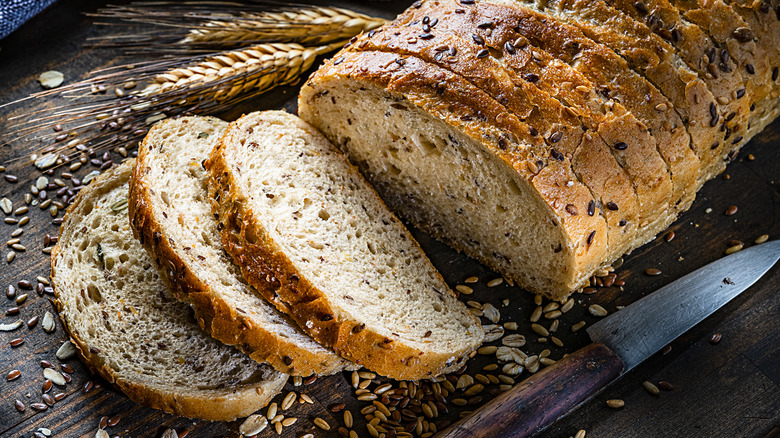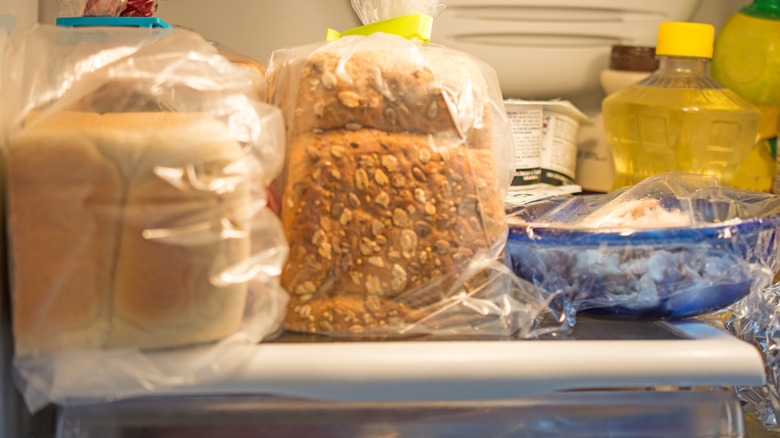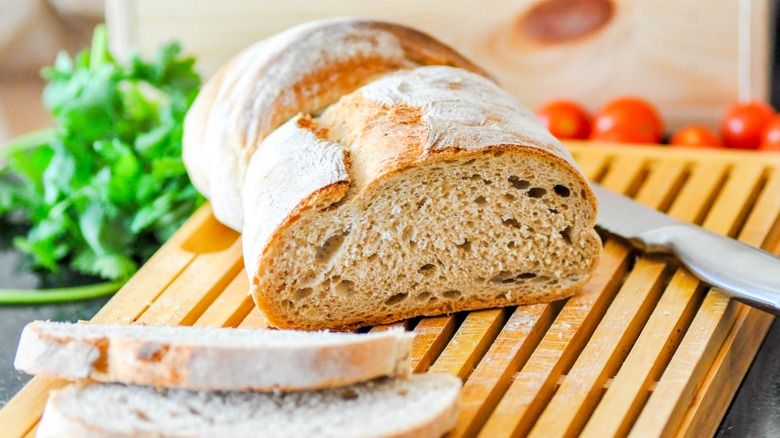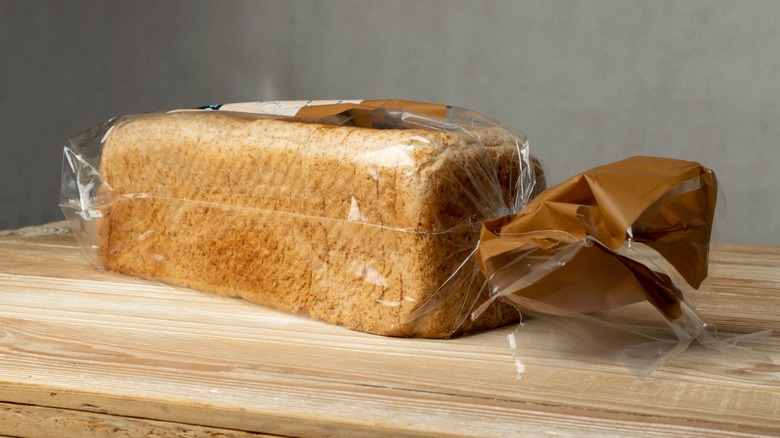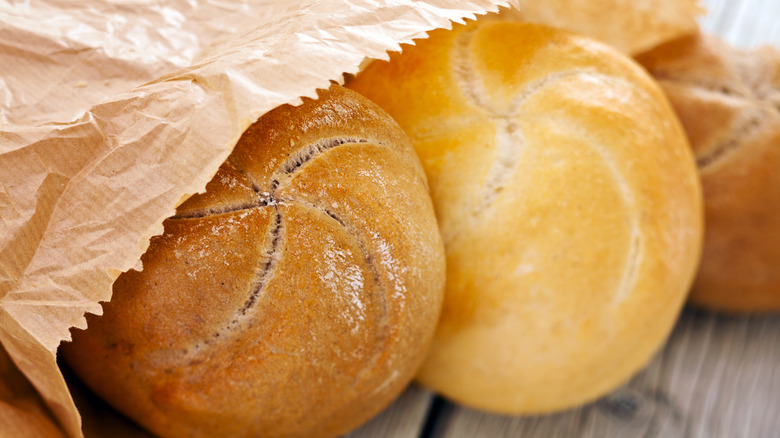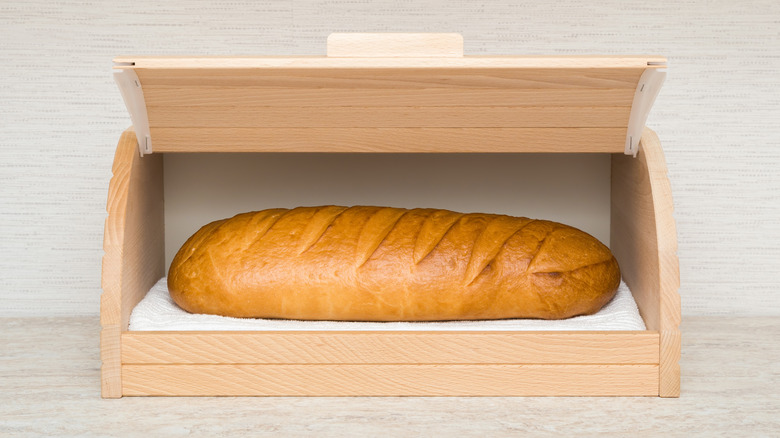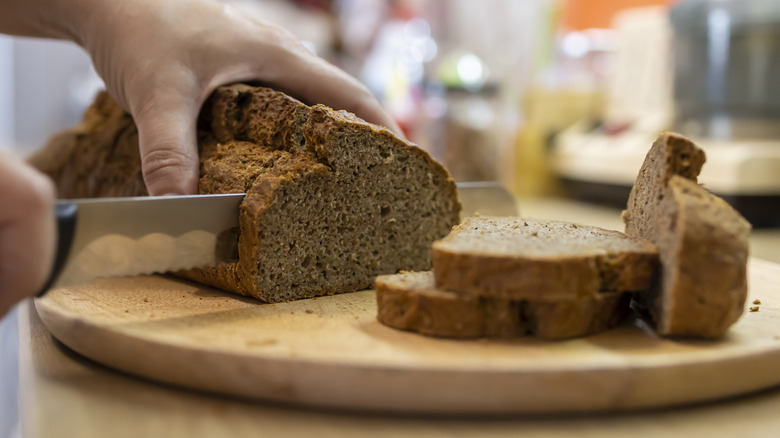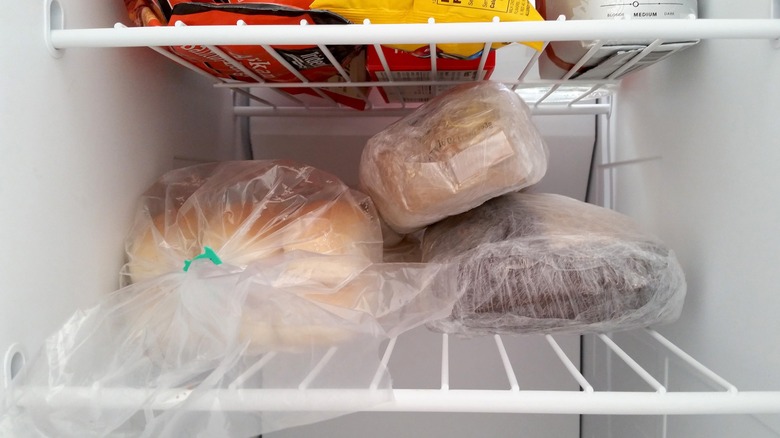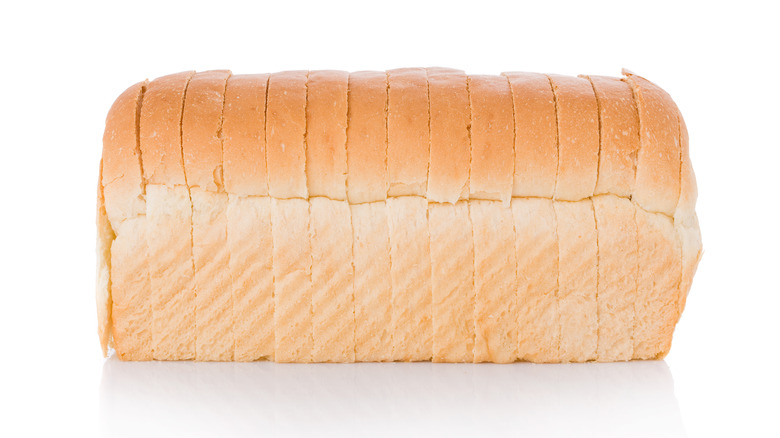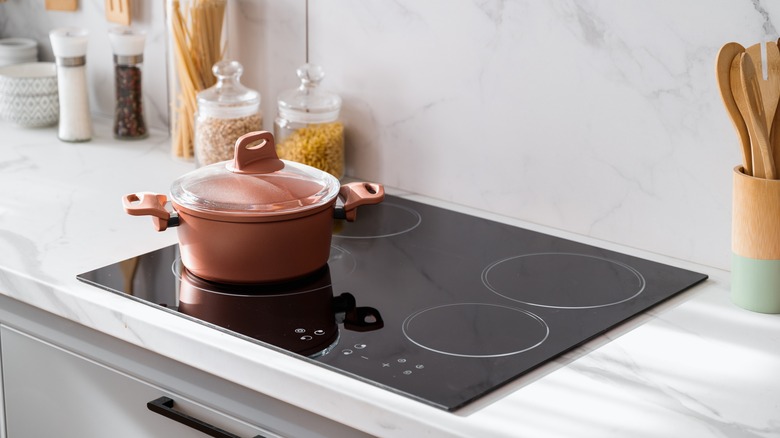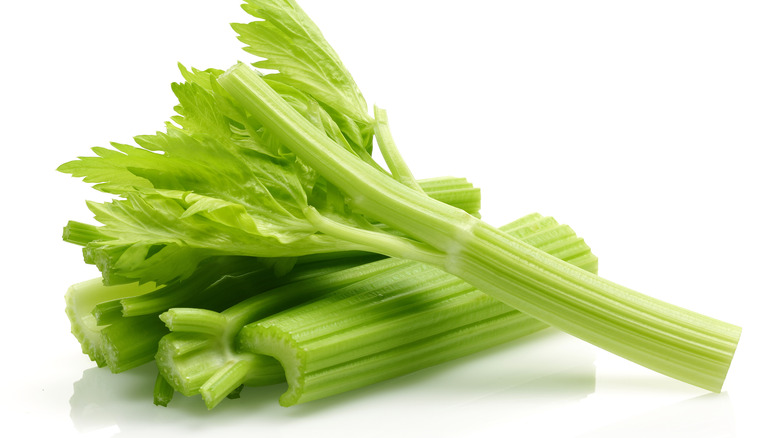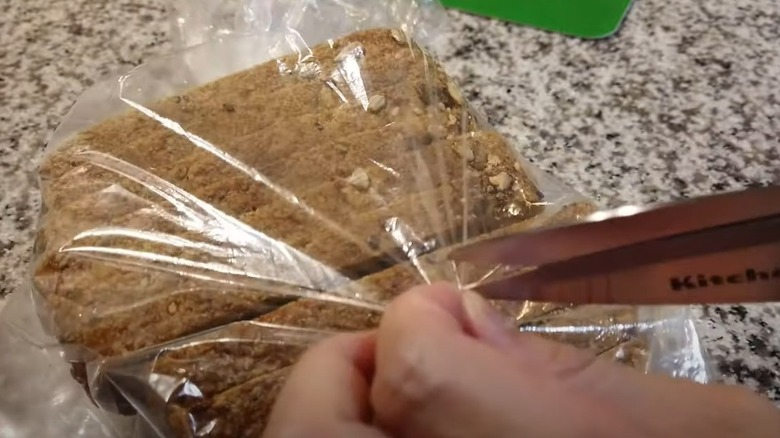The Biggest Mistakes You're Making When Storing Bread
Given that it's a staple in many of our kitchens, bread is a timeless favorite that can be enjoyed at any time of the day. Whether it's a crusty baguette, a soft sandwich loaf, or a hearty sourdough, there's something for every occasion via this nourishing comfort food. But despite its popularity, bread is surprisingly finicky when it comes to storage and many of us are unknowingly sabotaging our loaves with improper techniques.
So, we set out to uncover the most common mistakes we all make when it comes to storing bread. From popping it into the fridge in hopes we'll extend its freshness, to the often-overlooked significance of where it sits in our kitchens, there are many factors that can affect the quality of our bread. Consider the fine balance between preserving enough moisture in the bread to keep it soft, while keeping it from turning soggy or moldy.
If you want to learn how to preserve the flavor and texture of your favorite loaf and ensure that it stays fresh for as long as possible, this guide is for you. Say goodbye to stale, dry, or moldy slices and prepare to master the art of perfect bread storage.
Storing it in the fridge
It's a common misconception that the fridge is the best place to keep your bread fresh. After all, doesn't the cold environment slow down spoilage? While this might be true for many foods, bread is an exception. In fact, storing bread in the fridge can do more harm than good.
Mainly that's because the cold, dry air of the refrigerator accelerates the staling process. In this environment, the starch molecules in the bread rapidly crystallize as moisture is sucked out, which leads to an unappetizing dry, tough texture and bland flavor. Unlike other perishable items like milk or meat, bread is best kept at room temperature, in a cool, dry place away from direct sunlight and heat sources. If you live in a particularly warm climate or plan to keep your bread for an extended period, you can freeze it instead. Properly wrapped, frozen bread can maintain its freshness for months.
Another downside of refrigerating bread is the risk of it absorbing odors from other foods in the fridge. Bread is like a sponge, readily soaking up any nearby aromas. Storing it alongside pungent items like onions or cheese can result in an unpleasant flavor tainting your loaf. So, resist the temptation to refrigerate your bread, and you'll keep it soft, flavorful, and delicious for longer.
Storing it in a warm kitchen
We've established that the fridge is a no-go, but what if you live in a warm climate? While too cool of a temperature can dry out your bread, a warm, humid environment can also impact its freshness.
Excess heat and moisture provide the perfect conditions for microbial growth, so in a warm kitchen, you might find that mold forms on your bread after just a short period. To prevent this from happening, it's essential to find a balance between warmth and coolness in your kitchen. We understand that might not be as simple as it sounds, but a good place to start is finding the coolest, driest spot available. Somewhere with protection from light that maintains a relatively stable temperature is an ideal place, like a pantry or cupboard.
If your kitchen still tends to run too warm to leave bread out in the open, consider investing in a ventilated bread bin designed to regulate moisture levels and keep bread fresh. These containers provide a barrier against humidity and help prevent exposure to airborne contaminants that can accelerate spoilage. Alternatively, double-wrap your bread and pop it in the freezer for the greatest peace of mind.
Keeping it in the plastic packaging
The plastic bag that your bread was originally packaged in may seem like the most convenient option when in comes to storage, but the reality is that it's not doing your loaf any favors. While it might protect against immediate exposure to air and moisture, plastic can create a suffocating environment for bread, leading to spoilage and loss of freshness.
This is because plastic can trap moisture inside the bag, creating a humid environment that promotes mold growth and accelerates staling, particularly if your kitchen is warm. As moisture evaporates from the bread, it condenses inside the bag, creating the perfect environment for mold spores. Furthermore, the lack of airflow inside the plastic bag can cause the bread to become soggy and unappetizing. While the bread might seem ok for a few days in its plastic packaging, you might be surprised at how quickly your once-fresh loaf can become covered in unsightly mold spots.
To avoid soggy, moldy bread, opt for breathable storage options that allow air to circulate around the bread. A cloth bread bag or ventilated bread bin is a better alternative, as it provides some protection against moisture while still allowing the bread to breathe.
Keeping it in a paper bag
The humble paper bag may seem like another natural choice for storing bread. After all, fancy loaves from artisanal brands and local bakeries often come packaged in this way. But, paper bags are not without their drawbacks. While paper provides some protection against moisture loss, it's not an ideal long-term storage solution for preserving the freshness of your loaf.
While they are breathable to some extent, paper bags do not provide a sufficient barrier against air and moisture, with the porous nature of paper allowing moisture to escape easily. As a result, bread stored this way is susceptible to drying out quickly. Another downside of paper bags is their lack of durability. They are prone to tearing or puncturing, exposing your bread to potential contaminants and compromising its quality.
A paper bag is best used only as a short-term storage solution for freshly baked bread that you'll consume within a day or two. For longer-term storage, transfer your bread to a more suitable container or bag that provides better protection against moisture and air.
Putting it in a wooden bread bin
A bread bin can be an excellent solution for keeping bread fresh and flavorful, but the material it's made from can make all the difference in its effectiveness. For instance, a wooden bread bin might bring some rustic charm to your kitchen, but it isn't actually the best choice for preserving bread. With bread bins made from wood, it's easy for moisture to become trapped due to a lack of ventilation, which leads to condensation inside. This can result in soggy, moldy bread, particularly if the air is warm.
Wrapping your bread in a cloth or tea towel can create a good barrier between the bread and wood, preventing the bread from absorbing moisture. But, ultimately, it's best to opt for a bread bin made from a different material.
As reported by Express, German nutritionist Birgit Brendel advocates for ceramic bread bins. These containers are far more breathable than those made from wood or plastic, meaning air and moisture circulate through them more easily. A bread bin with small vents or openings can also be a great option that allows just the right amount of moisture to escape without allowing the bread to dry out.
Not storing it cut side down
Can how you position your bread really affect its freshness? Yes! Many people simply leave their loaf standing upright or place it on its side, but storing bread cut side down can make a significant difference to its longevity. That's because the crust of a loaf acts as a protective barrier that keeps moisture from evaporating too quickly. When bread is cut, its interior is exposed to air, causing it to dry out and accelerating the staling process. By storing the loaf cut side down, you create a barrier that helps to minimize exposure to air and subsequent moisture loss. The result is bread that stays fresher, softer, and more enjoyable for longer.
If you're using a bread bin or bag, try positioning the loaf with the cut side facing the base of the bin or the kitchen counter and see how this maximizes its freshness.
Not freezing it
Freezing bread is a game-changer when it comes to extending its shelf life. Yet, many people forget this simple preservation method that can lock in its freshness and allow you to enjoy bread for weeks or even months to come.
If it'll take you more than a few days to get through a loaf, freezing is your best bet. Before placing bread in the freezer, slice it up first so you can easily grab a slice or two to defrost as needed. Packaging it properly is key to keeping it fresh and preventing freezer burn. First, wrap the bread tightly in plastic wrap or aluminum foil to create a moisture barrier. Then, pop the wrapped bread in a food-safe freezer bag.
Packaged this way, bread should keep for up to two months in your freezer. When you're ready to enjoy a slice, simply remove it from the freezer and let it thaw at room temperature for a few hours. If you're toasting the bread, you can pop it straight into the toaster. Many toasters will have a dedicated defrosting setting perfect for this method.
Slicing the loaf before storing
Pre-sliced bread is, of course, a convenient option, but slicing a loaf before storing it in your kitchen can speed up its deterioration. When bread is sliced, more of its interior is exposed to air, accelerating the staling process.
To prolong the freshness of your bread, resist the urge to slice it until just before you're ready to use it. Keeping the loaf whole helps to retain moisture and preserves its soft, tender texture for longer. But what if you've already cut into it? When storing a partially sliced loaf, remember to store it cut side down in your bread bin or bag to protect it from the air.
If you prefer the convenience of pre-sliced bread, consider freezing it to keep it fresher for longer. You could even freeze just half of the loaf if you know you'll get through the other half within a few days.
Keeping it near the stove
If you're popping bread next to the stove for easy access during meal prep, you're making a definite mistake. Heat and moisture generated by cooking appliances can generate warm and humid conditions that are perfect for mold growth, leading to spoiled bread. Exposure to too much heat also causes the moisture within the bread to evaporate more rapidly, creating a dry, tough texture.
To preserve the freshness of your bread, it's always best to store it in a cool, dry place away from any heat sources that can damage the loaf. Even your fridge can generate enough heat to affect bread, so don't succumb to the temptation to store it on top of the appliance. A pantry or cupboard located away from the kitchen's heat sources is your best bet for bread storage. A bread bin with good ventilation can also provide additional protection against heat and humidity.
Filling your sandwiches in the wrong order
Prepping sandwiches in advance can be a great way to save time in the mornings, but adding fillings in the right order is crucial if you don't want to end up with soggy bread. The moisture content of your sandwich fillings is something you need to consider as you whip up your packed lunch.
When moisture-rich ingredients like tomatoes, cucumbers, or sauces come into direct contact with the bread, they seep into the crumb, softening the bread and creating ga mushy mess by morning. To prevent soggy sandwiches, layer your ingredients strategically. Start by spreading just a thin layer of butter or mayo on the bread, then create a moisture barrier on each slice using something like lettuce or cheese.
Next, layer your tomatoes, cucumbers, or other moisture-rich produce on top of the protective ingredients, followed by your protein or any other fillings. If you want to add some extra sauces to your sandwich, it's best to store these separately in a small container and add them just before you tuck in. Wrapping your finished sandwich in foil or plastic wrap also helps prevent it from drying out in the fridge overnight. When taking it on the go, popping the sandwich in a sturdy container will stop it from getting squashed in your bag, too.
Not adding a stick of celery to your bread bag or bin
Believe it or not, a simple stick of celery can be the secret to keeping your bread fresh longer. Celery has a very high water content, meaning it can act as a natural moisture regulator and keep the humidity around the bread just right. Furthermore, celery contains phthalates and apigenin, which have been shown to have both antifungal and antibacterial effects, which means celery can also prevent bread from becoming moldy.
Another factor in its effectiveness is the ethylene gas released by celery. This is the same gas associated with fruit ripening, but it can also affect bread. When released by the celery, ethylene slows the bread's conversion of starch into sugars, a process that can make bread firm and tough.
To harness the moisture-regulating properties of celery, place a clean, dry stick of the veggie in your bread bag or bin before closing it. This can help to keep the loaf soft and tender for longer. If the celery starts to become limp or shriveled, switch it out for a fresh stick.
Not making holes in your bread bag
If you don't have a more effective storage option like a bread bin or bag and have to keep your loaf in its original plastic packaging, then this nifty trick can help to keep it as fresh as possible. You'll simply be making a series of small holes in the bag.
These holes may not seem like much, but they can play a crucial role in regulating the airflow inside the bag. This prevents moisture buildup, reduces the risk of mold growth, and keeps the bread dry and fresh for longer. When bread is stored in a sealed bag without any ventilation, moisture from the bread itself or the surrounding environment can become trapped inside. This creates a humid environment that accelerates mold and bacteria growth, leading to premature spoilage and a shorter shelf life for your bread.
To make holes in your bread bag, simply use a sharp knife or pair of scissors to cut the bag in several places. Keep the holes small and space them evenly to ensure adequate airflow throughout the whole bag.
